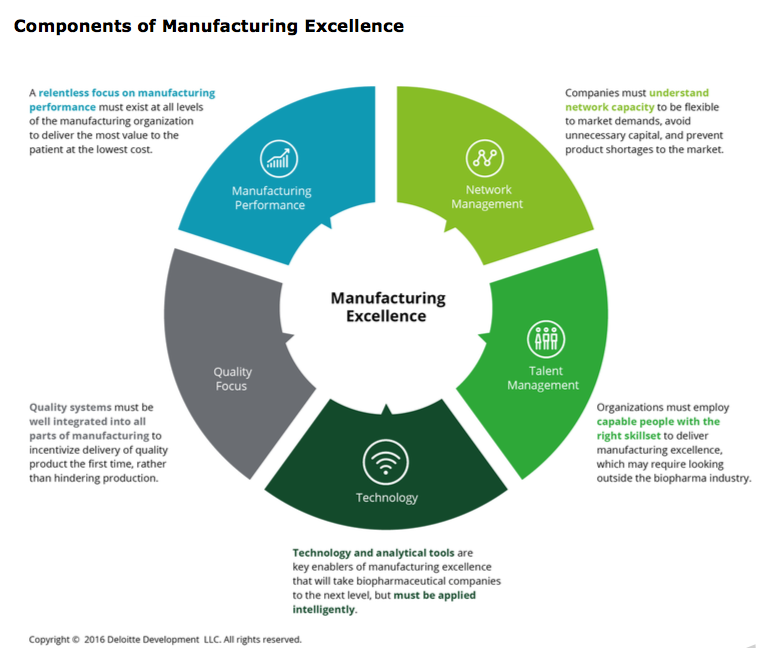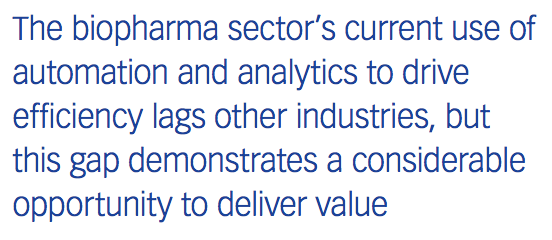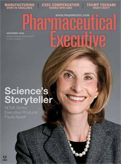Going to the Edge
Pharmaceutical Executive
How a Manufacturing Excellence program can deliver competitive advantage to a fast-changing global product mix-at lower cost, and with an unexpected workforce dividend to boot.
How life sciences companies can institute a manufacturing Excellence program in their global product strategies-with the goal of delivering competitive advantage, at lower cost.
Instituting manufacturing excellence should be an immediate and core priority for biopharmaceutical companies that want to achieve a sustainable competitive advantage.
Manufacturing excellence is characterized by a company’s ability to understand network capacity, focus on manufacturing performance, manage risk through its quality systems, employ people with the right skillsets and apply technology and analytical tools to improve product quality and company profitability.
Biopharma companies can realize considerable benefits from instituting or strengthening manufacturing excellence-transformative efforts at several large companies already have delivered hundreds of millions of dollars in cost reductions. For example, one global player in the industry recently delivered more than $400 million in potential annual savings through its manufacturing excellence initiatives. Another transformation at a biopharma company generated savings of $100 million and enabled the manufacturing organization to increase its flexibility and to increase its output by 23%.
While a complete transformation may not be appropriate for all companies, the potential financial and operational benefits of pursuing manufacturing excellence may be significant. Conversely, failing to deliver manufacturing excellence may result in shrinking profits from topline deterioration and rising production costs.
Why now? What has changed?
Historically, the biopharma industry was not known for being on the leading edge of manufacturing excellence, relative to other industries. Biopharma manufacturers largely focused on delivering quality products, while avoiding risk, often with little emphasis on optimizing manufacturing. However, emerging market and technology trends and a shift toward risk management are making manufacturing excellence critical to the future strength of biopharma companies’ top and bottom lines.
One key sector trend is the transition from producing traditional blockbuster drugs to targeted, niche therapies (e.g., orphan drugs) with smaller patient groups. These drugs increase manufacturing complexity due to their smaller batch sizes, which require more frequent equipment changeovers. These changeovers present more opportunities for quality failures and put greater pressure on manufacturing organizations to be efficient.
The small-batch nature of targeted therapies means that the volume of a product on the market will be lower than for conventional drugs. This presents topline pressures that compel companies to focus, more than ever, on increasing speed to market to maximize the total lifetime sales of therapies. Although regulatory reviews and clinical development are often perceived as the main drug approval bottlenecks, the FDA Center for Drug Evaluation and Research noted in December 2015 that manufacturing is often a rate-limiting factor in achieving expedited approval because of the inability to quickly scale production. Each day a launch goes past its scheduled date, drug developers lose as much as $600,000 in foregone sales for niche products and as much as $8 million for larger volume therapies.
Today’s global regulatory environment also factors into a company’s pursuit of manufacturing excellence. Global deployment of orphan drugs is crucial to maintaining topline performance due to lower volumes, so the manufacturing requirements of multiple regulatory bodies must be considered concurrently or in rapid succession. One reaction that companies may have is to build overly complex, costly, and risk-averse quality systems that are not sustainable. Avoiding risk does not necessarily ensure high product quality, and it can drive up costs and limit the manufacturing organization’s ability to institute improvements to gain production efficiencies.
The increasing prevalence of targeted therapies, such as CAR-T and gene therapy, is prompting companies to employ novel manufacturing processes, which further emphasizes the need for manufacturing excellence. For example, CAR-T therapy requires processing a patient’s own T-cells to fight diseases like cancer, moving manufacturing closer to the patient and limiting economies of scale. Also, in the instance of CAR-T, typical manufacturing processes, testing, and controls cannot readily be leveraged to create a cost-effective process. Companies will need to rethink how manufacturing, quality control and quality assurance interact with the patient to effectively and efficiently create and deliver such novel therapies.
Finally, the trend toward global manufacturing calls for an increased focus on finding, hiring and retaining talented people-particularly in leadership roles-who can deliver manufacturing excellence. The leadership skills needed going forward are not necessarily the same as those needed in the traditional landscape of blockbuster drugs and lesser cost pressures. Competition for the best talent can be fierce, requiring companies to be strategic in their approach to identify, attract, retain and develop people with the right skillsets for tomorrow’s manufacturing environment.
What do companies need to do?
Achieving manufacturing excellence is not easy-it requires company leaders to align and focus the entire organization, like never before, on developing and implementing transformative initiatives that promote efficiency and flexibility. The process starts with a well-defined business strategy followed by a capabilities evaluation to define the type of transformation that is required-from simplifying a quality management system to overhauling global operations. Ultimately, companies that proactively take steps to drive manufacturing excellence could gain a competitive edge.
What does manufacturing excellence look like?
Many manufacturing excellence principles are common across industries; however, there are some focus areas that are specific to biopharmaceuticals. The chart below shows the critical elements of biopharmaceutical manufacturing excellence.

Understand network capacity
Companies need to understand their network capacity to flex production to market demands, avoid unnecessary capital expenditures and prevent product shortages, particularly for life-saving drugs. While this need sounds obvious, gaining a thorough understanding of network capacity is not easy. When a company has a global network of facilities that may start and finish a manufacturing process in several geographic regions, it can be difficult to tell where the true bottlenecks exist. Too often, as demand rises and puts pressure on existing production resources, management’s first reaction is to decide that more capacity and facilities are needed. Fear of a market shortage compounds this issue and can lead to potentially unnecessary decisions to expand capacity.
In reality, what appears to be a capacity constraint issue is often an underutilization issue in disguise. As leaders better understand the capabilities of each facility and the interactions among them, a clear picture of perceived versus actual constraints may emerge and show what the organization is truly capable of producing. For example, one major biopharma company recently assessed its network of multiple manufacturing plants, along with its plans for two additional sites and a CMO to support production. The assessment found that significant unrealized capacity existed in the current network and could be realized through simple efficiency projects. Some of the resulting capacity gains were driven by cycle time reductions and additional operating days from maintenance optimization. The additional identified capacity alleviated perceived constraints on manufacturing capabilities. In today’s ever-changing landscape, a thorough understanding of network capacity can allow companies to make better strategic decisions, to cross-utilize their assets to manufacture several products and to plan for complexities associated with manufacturing a larger portfolio of niche therapies.
Emphasize manufacturing performance
Historically, quality and delivery have been the biopharma industry’s primary manufacturing drivers. This may be acceptable for companies producing high-volume, high-margin drugs; however, as patent cliffs and the rise of generics phase out the blockbuster era, companies also need to focus on manufacturing performance and more aggressively balance quality and delivery with costs to create an efficient operation. Still, executing on this may be difficult in biopharma organizations where cost pressures have not been as prevalent historically.
Focus areas for cost reduction depend on specific business needs. For a manufacturing system that requires minimal flexibility, common lean principles to reduce waste can be effective. In most cases, however, systems need to flex to market demands, new products and changing regulatory requirements. Therefore, it is important to identify which assets and process steps can provide flexibility and which can be removed. Manufacturing performance is not just about direct manufacturing costs; it’s also about balancing flexibility with both direct and indirect costs.
To enable topline growth, leaders need to develop flexible manufacturing capabilities that can produce many products quickly and scale to meet demand, while also managing costs. Targeted therapies are driving smaller production batch sizes and increasing the frequency of changeovers. This reduces economies of scale and makes production more difficult to manage. These two levers need to be balanced; leaders should look for win-win opportunities to drive both cost and flexibility improvements, such as reducing changeover time to concurrently enable more frequent product changes and reduce overhead costs incurred during production downtime.
Focus on quality system effectiveness
Strong, integrated quality systems are essential to achieving manufacturing excellence. Quality affects all aspects of a company-from its reputation, sales and costs to its working environment, employee morale and retention capabilities. To enable manufacturing excellence, companies must be compliant and deliver high-quality products, while not getting paralyzed by fear of regulatory citations and observations. Company leaders should create and nurture a culture where

employees are able to raise their hands about potential issues, without fear of retribution.
Sometimes when production issues arise, companies alter manufacturing process parameters and retest products without conducting proper root-cause analyses to uncover the reasons for the failures. Instead, quality should be addressed directly and proactively by embracing quality by design, improving quality controls, adopting forward-looking compliance metrics and emphasizing a culture that respects and builds quality into everyday business operations.
If a company’s quality management system and culture do not empower employees and incentivize problem-solving and a “right-the-first-time” mentality, then its leaders must identify ways to transform the quality mindset. Only then will the company move from firefighting and applying temporary solutions toward manufacturing excellence.
Employ capable people with the right skillsets
Employing and developing capable leaders with the right managerial and technical skills is critical to delivering manufacturing excellence. Biopharma manufacturing has traditionally focused on skillsets built around the technical aspects required to manufacture quality products. While quality is still paramount, leaders today must balance quality, cost and market demands while also managing production complexity. In addition, as the scope of leaders’ responsibilities expands to include global coordination and a focus on cost, they will need to develop a workforce that can execute against more and more demanding objectives. This presents challenges for the talent lifecycle.
Biopharma companies have several options to attract, retain, and cultivate top talent:
Develop from within. This requires organizations to become much more sophisticated at leadership development. Companies also will need to identify future leaders who may currently be in technical roles. Dimensions for evaluating leadership potential should be created and used to assess high-performers.
Compete for top biopharma talent. As leadership challenges increase, the demand for current industry executives will also increase. To compete for top talent, companies should develop attractive incentive packages that balance the appropriate salaries and bonuses with the required skillsets and desired autonomy levels.
Compete for top talent in other industries. There are many adjacent sectors, such as medical devices, advanced technologies and, to some extent, consumer products, which have similar leadership challenges but do not necessarily require the same baseline technical skillsets. Biopharma companies should consider bringing in proven leaders from other industries. For this approach to be successful, companies will need to refine their definition of a “qualified leader” skillset and find ways to test and evaluate external candidates against these parameters.
Apply new approaches and new technology
Technology applied strategically and intelligently can be a key enabler of manufacturing excellence and take a company to the next level. The biopharma sector’s current use of automation and analytics to drive efficiency lags other industries, but this gap demonstrates a considerable opportunity to deliver value. Two emerging approaches to bridge the gap are continuous manufacturing and single-use systems.
Continuous manufacturing is an evolution of batch manufacturing in which raw materials are continuously added and product is continuously generated. This is a

new approach in the industry and has shown tremendous potential for both large and small molecule systems. Continuous manufacturing systems are smaller, more scalable, and offer the potential for a more consistent product. In fact, continuous systems have been shown to deliver the same output from a five-liter continuous system as that seen with a traditional five-thousand-liter bioreactor. Instead of having distinct unit operations and using the traditional approaches associated with them, a continuous manufacturing plant needs to be designed and run holistically, utilizing more in-line testing and real-time process monitoring technologies.
Single-use equipment is another promising technology that is becoming more prevalent in biopharma manufacturing. While most operations use single-use technology on a limited basis, some companies are implementing single-use equipment across entire facilities. A big advantage of this technology is that it increases flexibility and up-time, as each operation can be modularized and changeovers can be performed more quickly because cleaning activities are limited. Other advantages include smaller facility footprint requirements, less maintenance and sterilization, less utilities use and less needed capital to build the facility. One specific limitation of single-use systems is scalability, but this is not a significant issue for companies that are migrating toward small-volume manufacturing.
Leaders should be strategic about integrating technologies that will help achieve their manufacturing and enterprise goals. This comes from understanding the pros and cons of each technology and weighing the risks during product development and commercial production. Smart application of technologies in manufacturing can launch companies toward achieving manufacturing excellence and gaining long-term competitive advantage.
Manufacturing excellence: First steps
Biopharma companies should consider taking three smart first steps to begin their manufacturing excellence journey:
1. Assess the existing manufacturing network to identify strengths to leverage and opportunities for transformative improvement.
2. Cultivate manufacturing leaders by developing internal talent, hiring externally, or both.
3. Align manufacturing excellence principles and business goals to identify the target balance between cost and flexibility that still maintains delivery of high-quality products.
John Furey is a Biopharmaceutical Executive and member of Pharm Exec’s Editorial Advisory Board. He can be reached at jpfurey@msn.com Matt Humphreys is Principal and Co-Leader of Deloitte Consulting LLP’s Life Sciences Supply Chain and Manufacturing Operations Practice. He can be reached at mhumphreys@deloitte.com Alex Sabad is Specialist Leader at Deloitte Consulting LLP, Head of Deloitte Consulting LLP’s Life Sciences Technical Operations Practice, and Global Life Sciences Manufacturing Strategy and Operations Lead. He can be reached at asabad@deloitte.com

The Misinformation Maze: Navigating Public Health in the Digital Age
March 11th 2025Jennifer Butler, chief commercial officer of Pleio, discusses misinformation's threat to public health, where patients are turning for trustworthy health information, the industry's pivot to peer-to-patient strategies to educate patients, and more.
Navigating Distrust: Pharma in the Age of Social Media
February 18th 2025Ian Baer, Founder and CEO of Sooth, discusses how the growing distrust in social media will impact industry marketing strategies and the relationships between pharmaceutical companies and the patients they aim to serve. He also explains dark social, how to combat misinformation, closing the trust gap, and more.
Applying Porter’s Five Forces to Portfolio Management in Pharmaceutical R&D: A Strategic Roadmap
March 17th 2025The increasing costs and complexity of R&D in the pharmaceutical industry have necessitated the adoption of strategic portfolio management to optimize resource allocation and enhance competitive advantage.